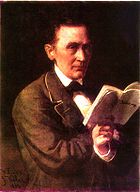
Friedrich Reinhold Kreutzwald
Encyclopedia

Estonian literature
Estonian literature refers to literature written in the Estonian language The domination of Estonia after the Northern Crusades, from the 13th century to 1918 by Germany, Sweden, and Russia resulted few early written literary works in Estonian language. The oldest records of written Estonian...
, who is considered to be the father of the national literature for the country.
Life
Friedrich's parents were serfsSerfdom
Serfdom is the status of peasants under feudalism, specifically relating to Manorialism. It was a condition of bondage or modified slavery which developed primarily during the High Middle Ages in Europe and lasted to the mid-19th century...
at the Jõepere estate, Virumaa
Virumaa
Virumaa is a former independent county in Ancient Estonia. Now it is divided into Ida-Viru County or Eastern Vironia and Lääne-Viru County or Western Vironia...
. His father worked as a granary keeper and his mother was a chambermaid. After liberation from serfdom in 1815, the family was able to send their son to school at the Rakvere
Rakvere
Rakvere is a town in northern Estonia and the county seat of Lääne-Viru County, 20 km south of the Gulf of Finland.-History:The earliest signs of human settlement dating back to the 3rd-5th centuries AD have been found on the present theatre hill. Probably to protect that settlement, a wooden...
district school. In 1820, he graduated from secondary school in Tallinn
Tallinn
Tallinn is the capital and largest city of Estonia. It occupies an area of with a population of 414,940. It is situated on the northern coast of the country, on the banks of the Gulf of Finland, south of Helsinki, east of Stockholm and west of Saint Petersburg. Tallinn's Old Town is in the list...
and worked as an elementary school teacher. In 1833, Kreutzwald graduated from the Faculty of Medicine at the Imperial University of Tartu
University of Tartu
The University of Tartu is a classical university in the city of Tartu, Estonia. University of Tartu is the national university of Estonia; it is the biggest and highest-ranked university in Estonia...
. He married Marie Elisabeth Saedler on August 18 the same year. From 1833 to 1877, he worked as the town physician in Võru
Võru
Võru is a town and a municipality in south-eastern Estonia. It is the capital of Võru County and the centre of Võru Parish.-History:Võru was founded on 21 August 1784, according to the wish of the Empress Catherine II of Russia, by the order of Riga Governor general count George Browne, on the...
, Livonia. He was the member of numerous scientific societies in Europe and received honorary doctorates
Honorary degree
An honorary degree or a degree honoris causa is an academic degree for which a university has waived the usual requirements, such as matriculation, residence, study, and the passing of examinations...
from a number of universities.
Writings
Kreutzwald is the author of several moralMoral
A moral is a message conveyed or a lesson to be learned from a story or event. The moral may be left to the hearer, reader or viewer to determine for themselves, or may be explicitly encapsulated in a maxim...
istic folk books, most of them translated into German
German language
German is a West Germanic language, related to and classified alongside English and Dutch. With an estimated 90 – 98 million native speakers, German is one of the world's major languages and is the most widely-spoken first language in the European Union....
: "Plague of Wine" 1840, "The World and Some Things One can Find in It" 1848–49, "Reynard the Fox" 1850, "Wise Men of Gotham" 1857. In addition to these works, he wrote the national epic
National epic
A national epic is an epic poem or a literary work of epic scope which seeks or is believed to capture and express the essence or spirit of a particular nation; not necessarily a nation-state, but at least an ethnic or linguistic group with aspirations to independence or autonomy...
"Kalevipoeg
Kalevipoeg
Kalevipoeg is an epic poem by Friedrich Reinhold Kreutzwald held to be the Estonian national epic.- Origins : There existed an oral tradition within Ancient Estonia of legends explaining the origin of the world...
" ('Kalev's Son') and many other works based on Estonian folklore
Estonian folklore
The earliest mentioning of Estonian singing dates back to Saxo Grammaticus Gesta Danorum . Saxo speaks of Estonian warriors who sang at night while waiting for a battle. Henry of Livonia in the beginning of the 13th. century describes Estonian sacrificial customs, gods and spirits. In 1578...
, such as "The Old Estonian Fairy-Tales" (1866), collections of verses and the poem "Lembitu" (1885), published after his death.
Kreutzwald is considered to be the author of the first original Estonian book. He was one of the leaders of the national awakening
Estonian national awakening
The Estonian Age of Awakening is a period in history where Estonians came to acknowledge themselves as a nation deserving the right to govern themselves. This period is considered to begin in 1850s with greater rights being granted to commoners and to end with the declaration of the Republic of...
, as well as a paragon
Paragon
A paragon is a large, flawless diamond. The title is now used figuratively to denote a model of excellence or perfection of any kind; one having no equal; a perfect embodiment of a concept.Paragon may also refer to:-Places:...
and encourager of young Estonian-speaking
Estonian language
Estonian is the official language of Estonia, spoken by about 1.1 million people in Estonia and tens of thousands in various émigré communities...
intellectuals.

